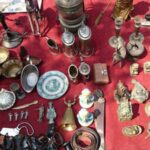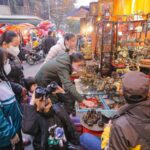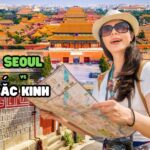
Nestled in the heart of Beijing, China, lies a unique market known as Daliushu. What started as a spontaneous open-air market has now transformed into a bustling hub of commerce and a city-wide sensation, famous for its weekly “Ghost Market.” Unlike the flashy signs and bright lights of typical markets, Daliushu exists as an outdoor museum, where locals reminisce and seek good fortune.
The Ghost Market: A Cultural Legacy in the Shadows
The concept of the “Ghost Market” (鬼市) is intertwined with Daliushu’s history, stemming from the late Qing Dynasty’s tradition of midnight markets. During this time, noble families and former court servants, faced with social upheaval, resorted to selling their family heirlooms. To avoid scrutiny and taxes, transactions took place under the cover of darkness, with buyers carrying lamps and sellers hiding amidst the crowd.
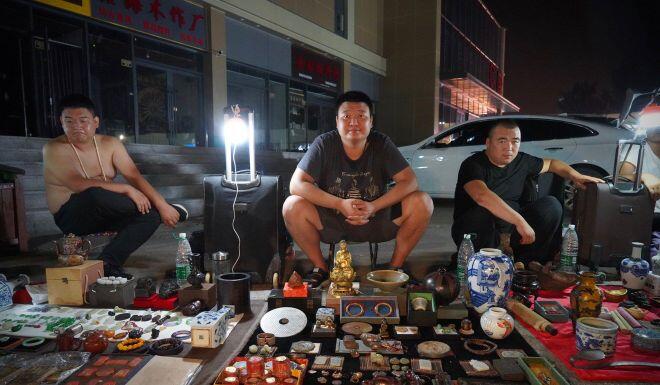
This tradition continues to thrive at Daliushu’s weekly Ghost Market, held every Tuesday from 5 pm to 2 am. In 2022, this market attracted approximately 3,000 visitors each night, ranging from antique collectors and tourists to locals seeking unique finds at bargain prices.
As night falls on market evenings, a stream of people carrying bags and suitcases, equipped with flashlights, make their way to Daliushu. Some bring large valises, while others carefully hold tool bags for examining stones. The soft footsteps, flickering lights, and quiet haggling create an atmosphere that is both serene and vibrant.
An Antique Universe: Where Fact and Fiction Blend
Daliushu is renowned for its antiques, earning the nickname “Antique Paradise.” Here, one can discover a Ming or Qing dynasty vase alongside scrap metal or 1970s vinyl records. The most sought-after items include:
Ancient ceramics: From flower vases and tea cups to small Buddha statues, with prices ranging from a few hundred thousand to tens of millions of Vietnamese dong. However, experts estimate that up to 70% of the antiques sold here are counterfeits, many crafted in Jingdezhen, known for its intricate replication of ancient artifacts.

Swiss watches: Brands like Omega and Rolex are commonly found here, mostly second-hand. While some lucky buyers score genuine articles, others end up with high-quality fakes.
Ink wash paintings and calligraphy: These artworks, along with folk paintings and books from the Republic of China era, evoke a nostalgic ambiance.
Jade: As a symbol in Chinese culture, jade is a significant presence at Daliushu. Experienced buyers often carry UV lights to examine raw stones, discerning authenticity through light penetration.
While mass-produced items masquerading as antiques are prevalent, it is this very blend of genuine and replica that gives the market its unique character. Visitors come to Daliushu not just to buy but also to test their luck, hone their observation skills, and negotiate prices based on their personal assessments.
A Consumer Shopping Paradise: Where Time and Modernity Collide
Apart from antiques, approximately 60% of Daliushu’s space is dedicated to consumer goods. From high-end leather jackets and traditional Chinese wedding dresses to whole-piece cowhide shoes, this market is a haven for fashion enthusiasts seeking affordable treasures.
It’s not uncommon to find a pair of leather boots for VND 1.8 million or a wedding dress for just VND 500,000. The “Russian area” offers a unique selection of imported goods from Siberia, including dark chocolate, vodka, and matryoshka wooden dolls.
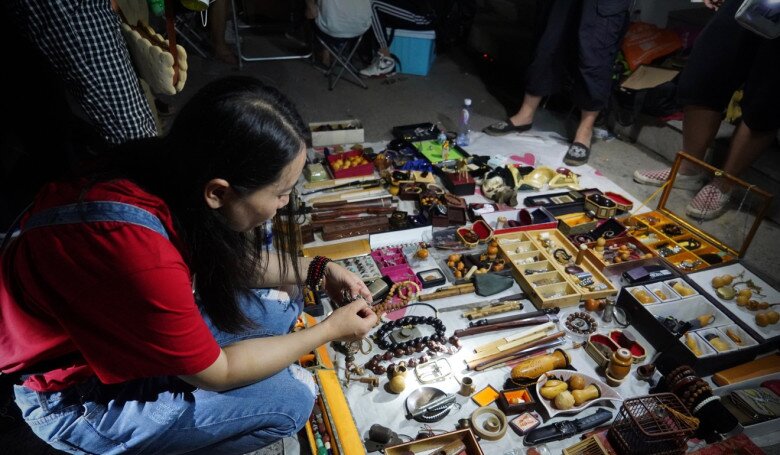
The home appliance section buzzes with activity, offering everything from induction cookers and pressure cookers to commercial-grade smoke extraction systems.
A Midnight Culinary Extravaganza
Daliushu’s culinary delights are the market’s soul. Over 50 mouthwatering street food options provide a “dine-all-night” experience:
– Mongolian-style mutton tripe hotpot (羊肚包肉): A traditional Mongolian dish where mutton tripe is stuffed with minced meat and herbs, then slow-cooked in a bone broth for over five hours.
– Roasted sweet potato cakes: Crispy on the outside, served with sour pickles and a special sauce, this treat costs only about VND 20,000 per serving.
– Stinky tofu: A notoriously pungent dish, served with Beijing’s signature spicy sauce.
– Taiwanese bubble tea: Mobile carts serve hot and cold bubble tea from evening until 2 am, priced at around VND 30,000 per cup.
Daliushu at midnight is more than just a marketplace; it’s a gathering spot for Beijing’s youth after work. Groups of friends huddle around hotpot tables, sharing stories amid the din and smoke, creating a scene that is both ordinary and extraordinary in the context of modern markets.
Experiential Tourism: A Journey Back in Time
Unlike a typical shopping mall, Daliushu offers a holistic travel experience. Evening food tours lasting three hours guide visitors through a variety of local specialties, from sweet to savory and from common to exotic. The highlight of this culinary journey is a hotpot cooked in an ancient copper pot, combining Mongolian mutton with over ten types of mountain vegetables.
For collectors, Daliushu is a treasure hunt in the dark. Flashlights illuminate intricate details, handheld magnifying glasses scrutinize fine prints, and UV lights are employed like tools in an actual treasure hunt.

In the midst of rapid urbanization, Daliushu stands as a bastion of Beijing’s night market culture. It preserves ancient trading customs while reflecting the challenging transformation of Chinese society, from tax-evading Qing dynasty nobles to today’s live-streaming merchants.
The Daliushu market is more than just a shopping destination; it’s a space where history is traded under the glow of flashlights, and where people seek memories amid the glittering modernity of city life. To understand Beijing, spend a night at Daliushu.
A Walk Through Hanoi’s Antique Market: A Time-Honored Tradition.
The annual antique fair, held on the intersection of five iconic streets – Hang Cot, Hang Luoc, Hang Ruoi, Cha Ca, and Hang Khoai – is a unique cultural phenomenon in Hanoi. This singular event, taking place on the 20th of the 12th lunar month, marks the arrival of the Tet holiday and the coming of spring.
Should I Visit Seoul or Beijing on My First Overseas Trip?
Seoul or Beijing: A Tale of Two Asian Cities for the Ultimate Travel Experience
Imagine immersing yourself in the vibrant, modern metropolis of Seoul, where the infectious energy of K-POP pulsates through the city’s veins, or stepping back in time in the ancient capital of Beijing, a city steeped in rich Chinese history and tradition. Which of these Asian powerhouses will offer the most memorable travel experience? It’s time to compare costs, culinary delights, and cultural adventures to uncover the perfect destination for your next journey!

























